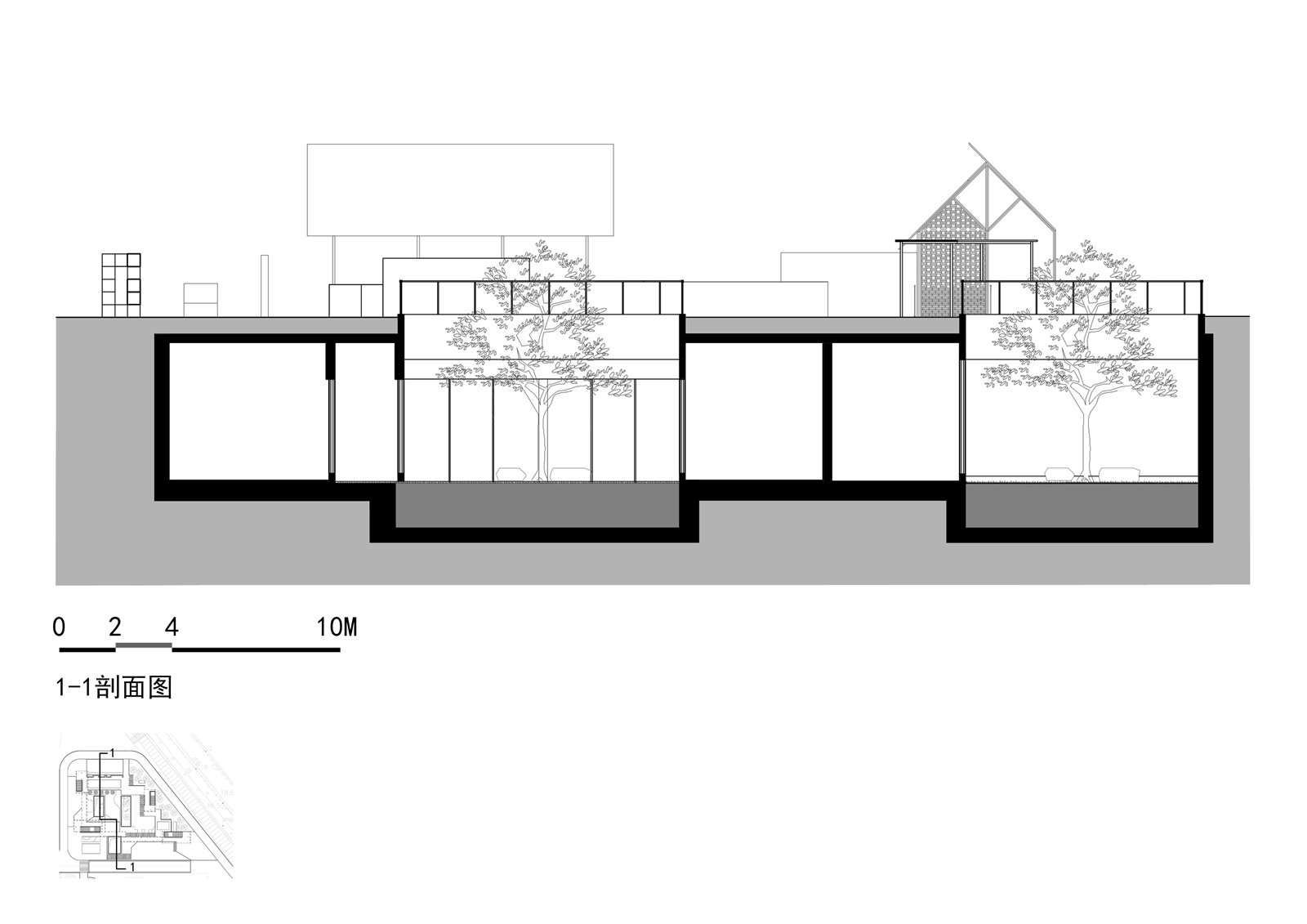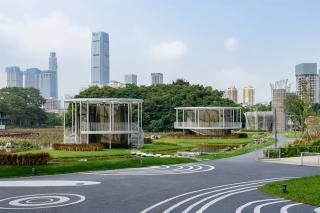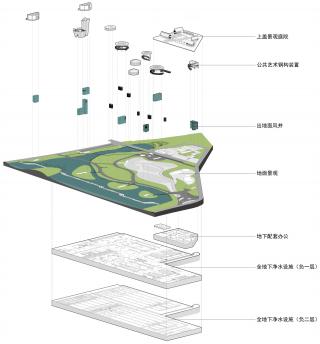深圳荷水文化基地暨洪湖公园水质净化厂上部景观设计 | 南沙原创
-
项目名称:深圳荷水文化基地暨洪湖公园水质净化厂上部景观设计
-
项目地点:深圳市罗湖区
-
项目规模:3.24万㎡
-
设计公司:
-
建成时间:2021年
-
图片来源:张超
全地下水质净化厂,地上城市公园
An Urban Park on Top of a Fully-buried Water Treatment Plant
▼基础设施公共化:深圳荷水文化基地 ©张超
Infrastructure Publicization: Shenzhen Lotus Water Culture Base ©Zhang chao

01 背景与历程
01 Background and History
项目位于深圳市罗湖区洪湖公园北端,泥岗东路南侧,布吉河东侧。洪湖公园是一个以荷花为主题的市级公园,坐拥落羽杉林和白鹭群。公园于1985年建成开放,既是深圳特区成立后最早建设的一批公园,也是深圳市民心目中最重要的城市公园之一。
The Project is located at the northern end of Honghu Park, Luohu District, Shenzhen City, south of Nigang East Road and east of Buji River. Honghu Park is a lotus-themed municipal park known for its bald cypress forest and white egret flock. Completed and opened in 1985, it is not only one of the earliest parks built after the establishment of Shenzhen Special Economic Zone, but also one of the most important urban parks in the eyes of Shenzhen citizens.
▼场地与城市周边空间关系 ©NODE
Relationship between site and surrounding space ©NODE

为了解决城市突出的水环境问题,《深圳市治水提质工作计划(2015-2020年)》于2015年发布,拟投入816亿元治水,新/扩建19座污水处理厂,改造24座污水处理厂,加快河流综合整治;其中新建的洪湖公园水质净化厂是此次深圳市水污染治理工作的重点工程,建成后每年可为周边区域净化生活污水约1800万立方米(约等于杭州西湖水量的1.3倍),将有效缓解清水河—笋岗片区城市更新发展带来的污水增量问题。洪湖公园水质净化厂采用的是全埋地式先进净水技术,对应需恢复的地面景观约3.24公顷。
To tackle the much-concerned water environment problems, the city released Shenzhen Water Control and Quality Improvement Work Plan (2015-2020) was released in 2015, which proposed an investment of CNY 81.6 billion on improvement of water environment, including construction and expansion of 19 sewage treatment plants, improvement of 24 ones, and accelerated river improvement initiatives. The newly built Honghu Park Water Purification Plant, one of the key projects for water pollution control under the Work Plan, employs a leading fully-buried water purification technology and involves the restoration of surface landscape of about 3.24 ha. It aims to effectively alleviate the sewage increase problems resulting from the urban renewal and development in Qingshui River - Sungang Area. Upon completion, the facility can treat and purify about 18 million m3 of domestic sewage for the surrounding areas every year, an equivalent of about 1.3 times the water volume of the West Lake in Hangzhou.
▼洪湖公园北侧地块原状航拍(施工前) ©西南市政院
Aerial in the north of Honghu Park (before construction)©Southwest Municipal Council

当我们介入项目之时,全地下水质净化厂已由市政工程设计单位完成设计及施工图并准备施工,我们承担的部分是净水厂上盖地面景观恢复设计,以及北端地下配套办公建筑设计。
When we joined the project team, the general contracting designer had completed the design and construction drawings of the underground water purification plant and everything had been ready for construction. In this project, we were asked to design the restored surface landscape on top of the water purification facility, and the underground offices at the northern end.
02 设计挑战
02 Design Challenges
虽然我们在该项目只负责地面景观提升,但因其与地下净水厂以及地表防洪工程要求息息相关,作为方案设计师,我们需要对景观设计背后的技术逻辑及生产流程及其逻辑有一定深度的理解和研究,并在此基础上超越工程逻辑,尝试创造一个符合空间美学、社区友好的公共空间场所。
Though we were engaged to only provide SD for the surface landscape improvement in the Project, we had to achieve sufficient understanding and conduct necessary research about the technical logic and production process/logic behind the landscape design, as the surface landscape is closely related to the underground facility and the surface flood control requirements. On this basis, we intended to go beyond the engineering logic, and tried to create an aesthetic and community-friendly public space.
水安全
Water Safety
每年涝季,场地西侧布吉河水位上涨,到达一定高度后,水流会从布吉河进入洪湖形成蓄洪区,缓解涝季水位上涨压力。设计场地为低洼地,位于行洪通道上,项目最终防洪安全评估标高,明确百年一遇的防洪标为12.4m,200年一遇的为13.4m。目前场地一方面需要景观提升,同时作为行洪的缓冲区,也要满足行洪通道的要求。谨慎处理现状场地标高和设计标高是保证水安全的基本要求。例如,出地面的风井门窗洞口,最低标高须达到百年一遇标高12.4m;而疏散楼梯出口和配套办公建筑而须达到200年一遇的13.4m。
In the flood season every year, the water level of Buji River west of the site rises. When the water level reaches a certain height, the river water will flow into Honghu Lake where a flood storage area is formed to alleviate the water level rise in the flood season. As the site is a low land that falls within the flood discharge passage, the final flood control safety assessment of the Project determined that the site elevation for 100-year flood is 12.4 m and that for a 200-year flood is 13.4 m. In this case, the site landscape needed improvement while meeting the requirement on flood discharge passage as a buffer for flood discharge. To ensure water safety, it was fundamental to tackle the existing site elevation and designed ones with due care. For example, the lowest elevation of the vent shaft door and window opening out of the ground must reach 100-year flood is 12.4 m; The evacuation staircase exits and supporting office buildings must reach 200-year flood is 13.4 m.
▼风井与滨水汀步 ©张超
Vent shaft and waterfront ting step ©Zhang Chao

水处理
Water Treatment
洪湖水质净化厂占地面积为1.67公顷,共分两期建设。水处理的技术部分采用全地下式双层框架结构,一期工程水处理规模为每天5万立方米,远期每天10万立方米。净化后出水作为洪湖公园和布吉河的生态景观补水,可达地表水环境质量准Ⅳ类标准的要求。该部分设计在我们介入之前,已由市政工程设计单位全部完成。全地下建筑不可避免地带来了许多地上建筑无需特殊处理的事宜,例如风井及消防疏散等在地面上显性的形式问题。原本埋地“去工业化”的初衷,在现实中又以另一种形式呈现和被带入。这也是这个项目的特殊之处,也是地面景观恢复设计最重要的挑战之一。
Honghu Lake Water Treatment Plant on a 1.67 ha site was to be built in two phases. The technical part for water treatment is a fully-buried double-layer frame structure, with the water treatment capacity of 50,000 m3 and 100,000 m3 per day in Phase I and long term respectively. The main indices shall meet the requirements of quasi class IV water body in the Standard for Environmental Quality of Surface Water. The treated effluent is used to supplement the water in the ecological landscape of Honghu Park and Buji River. The design for this part had been fully completed by the general contracting designer before we were brought aboard. In fact, the fully-buried building inevitably brought issues that need no special attention in the case of surface buildings, such as the forms of the visible above-grade part of the underground ventilation and fire control facilities, which were the focus of design. The original intention of buried facilities for "deindustrialization" was actually presented and brought into reality in another form. This was also the unique feature of the Project and one of the most important challenges facing the surface landscape restoration design.
▼地下净水(-1F)工艺流程示意图 ©NODE
Diagram of underground water purification (-1F) process ©NODE

▼地下净水(-2F)工艺流程示意图 ©NODE
Diagram of underground water purification (-2F) process ©NODE

▼地下净水厂(-1F)空间 ©张超
Underground Water Purification Plant (-1F) Space © Zhang Chao

多方诉求
Claims of Different Stakeholder
除了上述与水工程有关的设计挑战,由于洪湖公园在城市的重要地位和关注度,此项目的设计从一开始,多方(政府、公园方、运营方等)不同的诉求在我们介入后的各个阶段接踵而来。如政府方要求地面恢复绿化率达86%,符合湿地规划,处理好原生态鸟岛与景观的关系,并要结合海绵城市进行设计;公园方要求地面景观须让出近7000㎡作为荷花苗圃培育基地,恢复自然的湖岸线及水体近5000㎡;运营方则要求打造“去工业化“的野趣景观,结合公共科普参观,转化公众对“污水厂”的刻板印象等等。在我们看来,这是当下城市众多项目在设计过程中遭遇的典型问题,设计永远“在路上”,需要始终保持“变”的心态去应对不同阶段的各类述求,力保“在路上”的设计不影响施工的整体进度;但对我们而言,最大的挑战是在不断“变”的过程中要保证我们方案的初衷和设计最终的整体性。
In addition to the above water-related design challenges, we were also faced with various claims from different stakeholders (such as the government, the park authority, and Operator)as we started our designs, due to the park’s importance and much attention it had attracted. For example, the government required that the greening rate of the ground should be restored to 86%, the wetland planning be followed and the relationship between the original ecological bird island(s) and the landscape be well balanced under the sponge city concept. The park management needed nearly 7,000 m2 as a lotus nursery cultivation base, and the restoration of the natural lake shoreline and nearly 5,000 m2 of water body. The operators aspired for creating a “deindustrialized” wild landscape which, coupled with public science visits, may change people’s stereotype about “sewage plant”. In our opinion, these are typical issues encountered in the design process of many urban projects. Design is always "on the way", and we should always keep a "change-embracing" mindset towards various requirements in different stages, to ensure that the "on-the-way" design will not affect the overall progress of construction; but for us, the biggest challenge was to ensure the original intention and the final completeness of the design in a continuous "changing" process.
▼过程版野趣的Detour方案效果图 ©NODE
Process version of Detour scheme effect ©NODE

▼最终实施版方案效果图 ©NODE
Final implementation scheme effect picture ©NODE

水景观—基础设施公共化
Water Landscape - Infrastructure Publicization
正如上述所言,我们在方案设计过程中,一方面要整合地下生产性基础设施带来的技术难点或规范前置条件,另一方面要消化不同阶段的多方空间诉求,结合场地及我们自身的设计理念,不仅是还原和恢复公园用地景观,最终它也应该成为一个有别于传统纯景观设计的新型公共景观片区,兼具复合功能、美学追求、公共教育性和多样多层次的体验感。
As mentioned above, our SD design needed to, on one hand, streamline the technical difficulties or normative preconditions brought by underground production infrastructure and, on the other hand, incorporate the spatial demands of different stakeholders in different stages, the site conditions and our own design ideas. We should not only restore the park landscape, but also create a new public landscape area that is different from any conventional landscape-only design and realize the project goals in terms of mixed-use functions, aesthetic pursuit, public education and diversified and multi-level experience.
▼概念剖面示意 ©NODE
Concept section ©NODE

03 策略和设计
03 Strategy and Design Approach
鉴于上述的各种诉求和挑战,抓住工程设计与空间设计之间界面的核心问题是关键。
Given the above requirements and challenges, it is critical to focus on the core issue, i.e. the interface between engineering design and space design.
▼泄洪通道及防洪标高 ©NODE
Spillway and flood control elevation ©NODE

▼整体航拍: 突出地面的13个风井 ©张超
Overall aerial photograph: 13 vent shafts protruding from the ground © Zhang Chao

▼ 顺应场地,北侧用自然叠水消化高差 ©张超
To adapt to the site, the north side uses natural water to digest the height difference © Zhang Chao

▼ 轴侧功能图 ©NODE
Axis Side function diagram ©NODE

基础设施的艺术装置和公共化
Art Installation Treatment and Publicization of Infrastructure
两层地下净水厂的工程设计无疑在消防及排水等方面带来与地面建筑不同的挑战。出地面风井(部分含消防梯)大小共计13个,大小高度不一,与公园生态环境格格不入。公园方希望我们从原洪湖公园的岭南园林特色中提取历史符号, 做直接的装饰。但对我们而言, 不仅是简单“穿衣戴帽”的装饰, 还是可以结合公共体验和自然教育等理念,在空间层次、材料运用及造型语言上做更深层的转化?这是一个价值观与设计的双重问题。我们尝试对岭南园林的“塔、亭、榭、廊”空间原型进行适度的设计研究和“元素”提取,用当代设计语言及材料去做转化及表达,同时结合景观及植被特点,将文化和自然特点有效结合起来,尝试化解基础设施过于工程化的死板形象。
The engineering design of the two-floor underground water treatment plant undoubtedly posed challenges different from those faced by surface buildings in terms of fire protection, drainage, etc,. In particular, thirteen vent shafts (some containing fire evacuation stairs) of different sizes and heights protruded out of the ground level, an inharmonious contract with the ecological environment of the park. The park management encouraged us to extract historical symbols from the Lingnan gardens of the former Honghu Park and use them as ornamental elements. But we must figure out whether ornaments were simple “addition of symbols”, or they could be transformed at a deeper level in terms of space, material and shape in combination with the concepts of public experience, natural education, etc. This was an issue about values and design. We conducted some design research on and “element” extraction from the original spaces of the “pagodas, pavilions, gazebos and corridors” of Lingnan gardens, and transformed and expressed them with contemporary design languages and materials. Then we incorporated the cultural and natural characteristics based on the landscape and vegetation characteristics, and tried to dissolve the stereotype of the infrastructure resulting from overemphasized engineering features.
▼ 风井分布与公共装置类型示意 ©NODE
Vent shaft distribution and public device type ©NODE

▼ 装置概念演变 ©NODE
Device Concept Evolution ©NODE

▼风井与公共装置轴侧示意 ©NODE
Ventilation shaft and public device axis side diagram ©NODE

▼ 三种风井装置平面图:#5风井,#12中型风井,荷花塔 ©NODE
Three kinds of vent shafts device plan: #5 air shaft, #12 medium air shaft, Lotus tower ©NODE

▼三种风井装置剖面图:#5风井,#12中型风井,荷花塔 ©NODE
Three kinds of vent shafts device plan: #5 vent shaft, #12 medium vent shaft, Lotus tower ©NODE

譬如,最高的除臭风井离地面近16m,我们顺势而为,融合公园方反复强调的主题植物——荷花的元素,以公共艺术装置作为设计切入点进行三维抽象,同时设置观鸟观景平台,消解了必要存在、但形象上突兀的风井和疏散楼梯,使之成为“有用”的体验和洪湖公园重要的“荷花”地标。
For example, the highest deodorizing vent shaft was nealy16 m above the ground, and we naturally made it a 3D abstraction of lotus, the theme plant repeatedly emphasized by the park management, and a public art installation. The bird watching and observation platform helped eliminate the compulsory but visually-awkward vent shafts and evacuation stairs, injecting“useful” experience in them and creating an important lotus landmark in Honghu Park.
▼ 最高风井装置——荷花塔 ©张超
The highest vent shaft device -- Lotus Tower © Zhang Chao

▼荷花塔——楼梯上至平台 ©张超
Lotus Tower -- Stairway to platform ©Zhang Chao


▼荷花塔—细部结构 ©张超
Lotus Tower—Detail structure ©Zhang Chao

6个中型风井,结合疏散楼梯的功能,我们兼容了可上人体验的路径及平台,空间形态上也各有特点。其他6个小型风井立面上只简单采取景观覆绿和成为公园的避雨亭。在整个设计过程中,虽然地下工程不可避免地有不少意料之外的元素“被告知”,但我们一直努力避免过度设计:既不凸显,也无需遮掩,尽量因势利导,自然统一和谐。
The six medium-sized vent shafts containing evacuation stairs were designed with accessible paths and platforms, reflecting different characteristics in spatial form. The six small ones were dedicated for ventilation, so only facade greening on grilles of similar materials were employed to enhance the natural feel, including a rain shelter with seats. During the whole design process, we’ve been trying to avoid excessive design despite of many unexpected factors “informed” about the underground works. We neither highlight nor cover up, but instead, we made the best out of the project conditions to achieve natural unity and harmony.
▼ 通过水上汀步走入风井 ©张超
Walk through the water into the vent shaft ©Zhang Chao

▼轻盈钢结构包裹风井 ©张超
Light steel structure wraps the vent shaft ©Zhang Chao

▼ 地面步行系统 ©张超
Ground walking system ©Zhang Chao

▼ 慢行体验小径 ©张超
Slow trail © Zhang Chao

地下配套建筑:园林的显性与隐性呈现
Underground Supporting Building: Explicit and Implicit Presentation of Gardens
北端地下配套建筑整体主要功能为办公空间,因其位于洪湖公园的末端,位置较偏。如何创造足够的吸引力,引导公众发现并步行而至,这是个关键的设计问题。在此,我们采取了“软硬兼施”的设计策略:一方面是在办公功能之外,增加公共教育及科普功能,例如结合地下开放花园,设置一个可对公众开放的净水科普展厅;另一方面,在地面层,尝试做出一个有特色的公共空间及园林作为景观亮点及展厅的暖场区域,以吸引人流。The northernmost underground supporting building was planned as office space. As it stood at the end of the Park, geographically out of the way, how to create enough magnets to guide the public to discover and walk to it became a key design issue. As response, we adopted a design strategy that emphasizes both software and hardware. On the one hand, we added the functions of public education and science popularization on top of office function, such as creating a water purification exhibition hall in combination with the underground open garden; on the other hand, we tried to create a distinctive public space and garden on ground level as the landscape highlight and the pre-function zone of the exhibition hall to attract people.
▼ 北侧配套办公区 ©张超
Supporting Office area in the north ©Zhang Chao

▼配套办公区——地面园林景观 ©张超
Supporting office area — ground landscape garden ©Zhang Chao

▼ 配套办公区——地面园林廊亭 ©张超
Supporting Office Area -- Ground garden Gallery © Zhang Chao

在这里,我们顺延整体造园的概念,结合当代的造型语言及建构形式,以“亭廊”作为基本的、显性的空间要素,围绕地下开放花园,连接通往地下公共展厅及办公空间的流线,既致敬经典,又适当创新,形成一个曲径通幽、静谧又稍带神秘感的上盖花园。
Here, we extended the gardening concept. With reference to the contemporary formal language and constructional forms, we arranged the basic and explicit spatial elements of “pavilion and corridor” around the the underground open garden, and connected them with circulations to the underground public exhibition halls and office spaces. This approach, both a tribute to the classic precedents and a proper innovation, helped create a secluded, quiet and slightly mysterious surface garden.
▼ Logo景观墙概念效果示意 ©NODE
Concept effect of Logo Landscape wall ©NODE

▼ 景墙实景 ©张超
Landscape Wall ©Zhang Chao

04 结语
04 Conclusions
这个项目从我们开始介入地面景观设计到完工,历时四年有余,无论是生产工艺及景观建筑设计的跨界和方法论,还是对专业设计及施工质量有共同的标准共识,仍任重而道远,尚需共同努力。
洪湖公园地下水质净化厂及地面景观恢复项目完成后,很荣幸地被提升命名为“深圳荷水文化基地”。这是南沙原创团队多年来在基础设施公共化系列里,对净水生产与景观建筑跨界设计实践的另一次重要尝试。一如既往,我们希望通过景观/建筑师主动的设计努力,让一个日常生活中无法缺席的工程净水生产设施,成为城市中一个良好的、带有仪式感的公共体验和教育场所,重新赋予基础设施在精神和景观/建筑美学两个维度的意义。
The project lasted four years from the commencement of our surface landscape design to the project completion. However, for such infrastructure projects posing major engineering and aesthetic challenges, the consensus and cooperation among different disciplines and professional practices cannot be reached overnight. In fact, there is still a long way for us to go, and all stakeholders need to work together toward this goal.Upon its completion, the project was renamed as Shenzhen Lotus Water Culture Base. It represents another important attempt of NODE team in infrastructure publicization projects over the years in terms of interdisciplinary design practice of water purification and landscape architecture. As always, we hope that, through the active design efforts of landscape architects/architects, the water purification facilities that are indispensible for our daily life will become pleasant and ceremonial places in the city for public experience and learning, thus redefine the significance of infrastructure from the dimensions of spirit and landscape/architectural aesthetics.
▼夕阳中的荷花塔与风井 ©张超
Lotus Tower and Vent Shaft in sunset © Zhang Chao

▼夜景 ©张超
Night view © Zhang Chao

设计图纸
▼ 总平面图 ©NODE
Master plan ©NODE

▼ 总剖面图 A-A ©NODE
Section A-A ©NODE

▼ 总剖面图B-B ©NODE
Section B-B ©NODE

▼配套办公区平面图 ©NODE
Plan of supporting Office Area ©NODE

▼ 配套办公区(-1F)平面图 ©NODE
Supporting Office Area (-1F) Plan ©NODE

▼配套办公区剖面图1-1 ©NODE
Profile of supporting office area 1-1 ©NODE

▼配套办公区剖面图2-2 ©NODE
Profile of supporting office area 2-2 ©NODE

▼ 配套办公区廊亭大样 ©NODE
Supporting office Area Gallery Pavilion layout ©NODE

▼荷花塔平面图 ©NODE
Plan of lotus Tower ©NODE

▼荷花塔剖面图 ©NODE
Lotus Tower section ©NODE

▼ 风井平面图 ©NODE
Vent shaft plan ©NODE

▼风井剖面图 ©NODE
Ventilation shaft profile ©NODE

▼楼梯大样 ©NODE
Stair details ©NODE

▼叠水剖面大样 ©NODE
Large sample of superimposed water section ©NODE

项目信息
项目名称 : 深圳荷水文化基地暨洪湖公园水质净化厂上部景观设计
项目类型:基础设施
项目地点:深圳市罗湖区
设计单位:南沙原创建筑设计工作室
主持建筑师:刘珩
设计团队完整名单:
方案及项目全过程:刘珩、黄杰斌、黄赞宁
总体实施方案:刘洋、徐静悦、林小红、黄俊豪、卢维敏(实习)
总体方案过程:杨嘉惠、徐志波、卢青松
风井方案过程:周宇鹏、曾舒亚(实习)、王蔓芷(实习)
配套建筑:汤越宇(实习)、李鑫(实习)、田皓元(实习)
建成状态:建成
设计时间:2017.11-2021.03
建设时间:2020.10-2021.09
用地面积:地面景观恢复3.24万㎡
建筑面积:地下配套办公及展览1760㎡
建设方:深圳市水务(集团)有限公司
地面景观恢复+地下配套建筑设计单位:南沙原创建筑设计工作室
地下净水厂工程设计单位:中国市政工程西南设计研究总院有限公司
设计总承包及施工图单位:中国市政工程西南设计研究总院有限公司
结构+机电:中国市政工程西南设计研究总院有限公司
灯光顾问:深圳光程式科技有限公司
结构体系:混凝土框架(净水厂出地面风井)+ 钢结构(风井装置) ,剪力墙结构(地下配套建筑),钢结构(配套建筑地面亭廊)
材料:氟碳喷涂钢材、青砖及青砖片、透水沥青、透水砖、花岗岩、塑木
摄影师:张超
Project Name: Landscape Design for Shenzhen Lotus Water Culture Base and Ground Level of Honghu Park
Water Purification Plant
Project type: Infrastructure
Location: Luohu District, Shenzhen city
Design : NODE Architecture & Urbanism
Lead Architects: Doreen Heng Liu
Program and project process: Doreen Heng Liu,, Jiebin Huang, Zanning Huang
Overall implementation plan: Doreen Heng Liu,, Jingyue Xu, Xiaohong Lin, Junhao Huang,Weimin Lu(internship)
Overall program process: Jiahui Yang, Zhibo Xu, Qingsong Lu
Vent shafts scheme: Yupeng Zhou, Shuya Zeng(internship), Manzhi Wang (internship)
Supporting Buildings: Yueyu Tang(internship), Xin Li (internship), Haoyuan Tian(internship)
Completed status: Completed
Design time: 2017.Nov-2021.Mar
Construction time: 2020.Oct-2021.Sep
Site area: Ground landscape restoration 32,400 sqm
Floor area : Underground supporting office and exhibition 1760 sqm
Construction: Shenzhen Water (Group) Co., LTD
Ground landscape restoration + underground supporting building design scheme and deepening :
NODE Architecture & Urbanism
Underground water purification plant engineering design : China Municipal Engineering Southwest Design and Research Institute Co., LTD
Design contractor and construction drawing: China Municipal Engineering Southwest Design and Research Institute Co., LTD
Structure + electromechanical: China Municipal Engineering Southwest Design and Research Institute Co., LTD
Lighting Consultant: Shenzhen Light Program Technology Co., LTD
Structural system: concrete frame (air shaft of water purification plant) + steel structure (air shaft device), shear wall structure (underground supporting building), steel structure (ground pavilion gallery of supporting building)
Materials: fluorocarbon coated steel, green bricks and tiles, permeable asphalt, permeable bricks, granite, plastic wood
Photographer: Zhang Chao
版权声明:本文版权归原作者所有,请勿以景观中国编辑版本转载。如有侵犯您的权益请及时联系,我们将第一时间删除。
投稿邮箱:info@landscape.cn
项目咨询:18510568018(微信同号)

























































